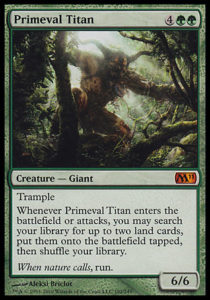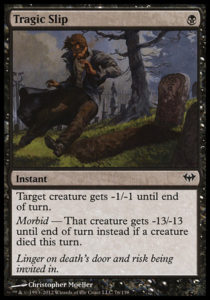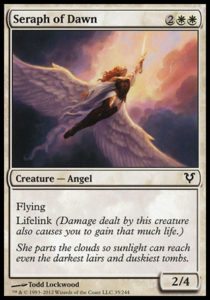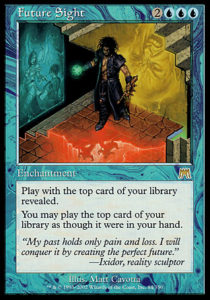Heard this one before?
“Card X is great!”
“Not really. Dies to Doom Blade.”
Every (non-black) creature can be subject to this test: The vast majority do indeed die to Doom Blade. Despite this, people still frequently played Goblin Guide, Baneslayer Angel, Hero of Bladehold, Delver of Secrets, and a host of other creatures. These aren’t creatures that produce card advantage like Flametongue Kavu, Mulldrifter, and Reveillark; when they were void-cut like steel, it was as though they never existed (no matter how powerful they would have been had they lived).
Having powerful and inexpensive kill spells like Doom Blade dramatically alters an environment. In Constructed, expensive creatures really need to justify their mana costs if a Doom Blade, Lightning Bolt, Dismember, Path to Exile, or Swords to Plowshares can dispatch them. Using a two-mana spell to deal with a six-mana Consecrated Sphinx provides mana advantage; if my opponent taps out, and I deal with her threat and have enough mana to end-of-turn Vendilion Clique her, then I’m far ahead. In Limited, having inexpensive, unconditional (or marginally conditional in the case of Doom Blade) removal spells at common means that decks can have multiple copies. Control decks become much better when they can trade their mediocre creatures for their opponents’, Terror any major threats, and win the game with sub-par but uncontested creatures.
When I started playing Magic again during Scars of Mirrodin block, the ubiquity and power of removal led to a Standard dominated by the five M11 Titans: creatures so powerful that they won the game if left alive, produced so much advantage on entering the battlefield that Doom Blading them left the Titan player far ahead, and polarized the format into decks that ran countermagic like Mana Leak in order to prevent the giants from ever hitting the field, and decks that ran Titans (and decks that did both). These were generally the only expensive creatures considered playable (barring a few exceptions like Consecrated Sphinx and Wurmcoil Engine, which were effectively the second blue and colorless Titans).
For the past two years, Magic has experimented with weaker-than-usual removal, particularly at common. In Innistrad, this was perfect—the morbid mechanic and cards like Stitched Drake meant that one often wanted creatures to die, even one’s own. This made situations unusually tense and exciting. When your opponent makes a seemingly poor attack, you wonder what combat tricks are up her sleeve. In Innistrad, you’d have to worry about enabling a morbid Brimstone Volley or Morkrut Banshee. Sometimes, your opponent wanted you to eat her Walking Corpse with your Galvanic Juggernaut, so she could in turn eat it with her Banshee! These situations wouldn’t have been nearly as exciting if cards like Doom Blade were in the format.
This trend continued in Avacyn Restored. While weak removal was a proud feature of Innistrad, it was one of the biggest defects in AVR. Removal was bad—but there was no mechanical reason for it in a set that didn’t care much about graveyards. Sure, it meant that my soulbonded Trusted Forcemage and Wingcrafter wouldn’t be easily divorced, but there were few ways to interact with an opponent’s board other than smashing your creatures in and racing. Creatures like Mist Raven and Seraph of Dawn could single-handedly win these races, while kill spells like Death Wind and Righteous Blow couldn’t keep up.
By now, Wizards appears to be cracking the formula for removal. Return to Ravnica block is full of common removal, from Annihilating Fire to Punish the Enemy—but all of it is worse than Doom Blade, either in lethality, mana cost, or both. Sure, Fatal Fumes is a really, really, bad Disfigure 95% of the time, but still we put it in our decks. The best common removal spells are gems like Stab Wound, Mugging, and Grisly Spectacle—all quite good, but weaker than Terror, Shock, and Doom Blade. Unconditional removal spells like Putrefy, Dreadbore, Arrest, Assassin’s Strike, and Trostani’s Judgment are at higher rarities or mana costs than they might have been previously. This seems indicative of Wizards’ direction as regards current removal.
Next month, if I’m not mistaken, Doom Blade will return in Magic 2014 as an uncommon. No longer will the (more elegant, but weaker and less splashable) Murder be the standard for removal, but no longer will Doom Blade be the standard for quality common removal. We’ve moved into a new era of Magic, one where common removal like Prey Upon and Angelic Edict is neither difficult to come by nor as high as pick as Doom Blade or Lightning Bolt. Those who strictly follow B.R.E.A.D. (Bombs Removal Evasion and whatever A. and D. mean to your local community) pick order should recognize that many removal spells will not be high picks (Viashino Firstblade and Darkthicket Wolf aren’t bombs, but I’ll happily take them over lackluster removal such as Fatal Fumes and Harvest Pyre). I expect that Limited formats with a reasonable quantity of middle-to-low quality removal at common (supplemented with higher quality removal at uncommon) will make for great draft and sealed experiences.
With Magic 2014, Constructed will regain its powerful removal and the Doom Blade test will return. As long as there aren’t too many efficient ways to kill creatures, there should hopefully not be another reign of the Titans and players will be happy to fill their decks with creatures that are awesome… even though they die to Doom Blade.
-Zachary Barash
twitch.tv/ZennithGP





